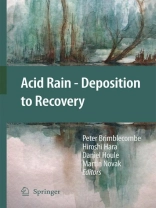This book looks at the sources and composition of the atmosphere and rainfall, with particular attention on acidifying components and those that affect ecosystems. It further widens the subject to look at trace metals. It includes papers on the impact of deposition on soils and forests and the recovery of the natural environment. Work on critical loads makes a contribution to understanding the degree to which deposition must be reduced to limit its impact.
İçerik tablosu
Modelling Seasonal Dynamics from Temporal Variation in Agricultural Practices in the UK Ammonia Emission Inventory.- Inter-annual Variations of Ozone and Nitrogen Dioxide Over Europe During 1958–2003 Simulated with a Regional CTM.- Field Intercomparison of Main Components in Air in EMEP.- Variations in the Fluoride Level in Precipitation in a Region of Human Impact.- Long Term Trends in Sulphur and Nitrogen Deposition in Europe and the Cause of Non-linearities.- Trends in Chemical Composition of Wet-only Precipitation at Rural French Monitoring Stations Over the 1990–2003 Period.- Monitoring Long-term Trends in Sulfate and Ammonium in US Precipitation: Results from the National Atmospheric Deposition Program/National Trends Network.- Temporal Trends of Non-sea Salt Sulfate and Nitrate in Wet Deposition in Japan.- Sulphate and Nitrate in Precipitation and Soil Water in Pine Forests in Latvia.- Acid Rain in Downtown São Paulo City, Brazil.- Atmospheric Metal Pollutants-Archives, Methods, and History.- Nitrogen Saturation of Terrestrial Ecosystems: Some Recent Findings and Their Implications for Our Conceptual Framework.- Effects of Nitrogen Deposition on Bryophyte Species Composition of Calcareous Grasslands.- Atmospheric Deposition of Reactive Nitrogen on Turf Grassland in Central Japan: Comparison of the Contribution of Wet and Dry Deposition.- Effects of Nitrogen Supply on the Sensitivity to O3 of Growth and Photosynthesis of Japanese Beech (Fagus crenata) Seedlings.- Stem Growth of Picea Abies in South Western Sweden in the 10 Years Following Liming and Addition of PK and N.- X-ray Microanalysis of Needles from Douglas Fir Growing in Environments of Contrasting Acidity.- Effects of Acid Rain on Competitive Releases of Cd, Cu, and Zn from Two Natural Soils and Two Contaminated Soils in Hunan, China.- Modelling Change in Ground Vegetation Response to Acid and Nitrogen Pollution, Climate Change and Forest Management at in Sweden 1500–2100 A.D..- Laboratory Measurement of Dry Deposition of Ozone onto Northern Chinese Soil Samples.- Ozone Deposition to a Coniferous and Deciduous Forest in the Czech Republic.- Impact of Harvest Intensity on Long-Term Base Cation Budgets in Swedish Forest Soils.- Long Term Effects of Acid Irrigation at the Höglwald on Seepage Water Chemistry and Nutrient Cycling.- Nitrogen Budget of a Spruce Forest Ecosystem After Six-year Addition of Ammonium Sulphate in Southwest Sweden.- Modification of Soil Solid Aluminium Phases During an Extreme Experimental Acidification of A Horizons of Forest Soils from Southwest Europe.- Exposure Programme on Atmospheric Corrosion Effects of Acidifying Pollutants in Tropical and Subtropical Climates.- UN/ECE ICP Materials Dose-response Functions for the Multi-pollutant Situation.- Long-term Trends in Surface Water Quality of Five Lakes in Japan.- The Fernow Watershed Acidification Study: Ecosystem Acidification, Nitrogen Saturation and Base Cation Leaching.- Response of Drinking-water Reservoir Ecosystems to Decreased Acidic Atmospheric Deposition in SE Germany: Signs of Biological Recovery.- Invasives, Introductions and Acidification: The Dynamics of a Stressed River Fish Community.- Fish Stomachs as a Biomonitoring Tool in Studies of Invertebrate Recovery.- Acidification at Plastic Lake, Ontario: Has 20 Years Made a Difference?.- Modeling Acidification Recovery on Threatened Ecosystems: Application to the Evaluation of the Gothenburg Protocol in France.- Recovery of Acidified Lakes: Lessons From Sudbury, Ontario, Canada.- Relationships Between Macroinvertebrate Assemblages of Stony Littoral Habitats and Water Chemistry Variables Indicative of Acid-stress.- A Novel Environmental Quality Criterion for Acidification in Swedish Lakes—An Application of Studies on the Relationship Between Biota and Water Chemistry.- Effects of Liming on the Aquatic Fauna in a Norwegian Watershed: Why Do Crustaceans and Fish Respond Differently?.- Recovery of Acidified Streams in Forests Treated by Total Catchment Liming.- Cost-effectiveness Analysis of Reducing the Emission of Nitrogen Oxides in Asia.- European Critical Loads of Cadmium, Lead and Mercury and their Exceedances.- Critical Loads and Dynamic Modelling to Assess European Areas at Risk of Acidification and Eutrophication.- On the Calculation and Interpretation of Target Load Functions.- Comparison of Critical Load Exceedance and Its Uncertainty Based on National and Site-specific Data.- Setting Site Specific Critical Loads: An Approach using Endorsement Theory and Dempster—Shafer.- Why Critical Loads of Acidity and N for Soils Should be Based on Pollutant Effective Concentrations Rather Than Deposition Fluxes.- The Applicability of National Critical Loads Data in Assessing Designated Sites.












